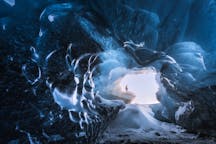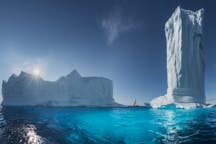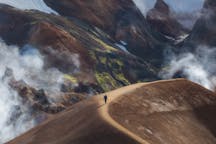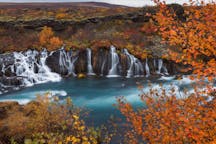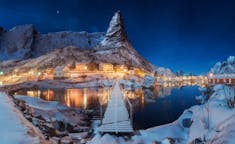
How to Photograph the Diamond Beach in Iceland

Have you seen those amazing photos of the black sand beach in Iceland, where it looks like diamonds have washed ashore? Have you been wondering about how to photograph the spectacular Diamond Beach on Iceland's South Coast?
- Learn all about The Power of Foreground in Landscape Photography of Iceland
- Discover the Ultimate Guide to Iceland Photography
Breiðamerkursandur, popularly known otherwise to visitors as the Jökulsárlón ice beach, is one of the most amazing photography spots on the South Coast of Iceland. Where else in the world would there be glacier ice cubes polished like diamonds on a Black Sand Beach? In this article, we will show you how you can take beautiful photos of ice beach like a Pro. But before we begin, let us provide you with some information on safety.
How to Stay Safe at the Diamond Ice Beach
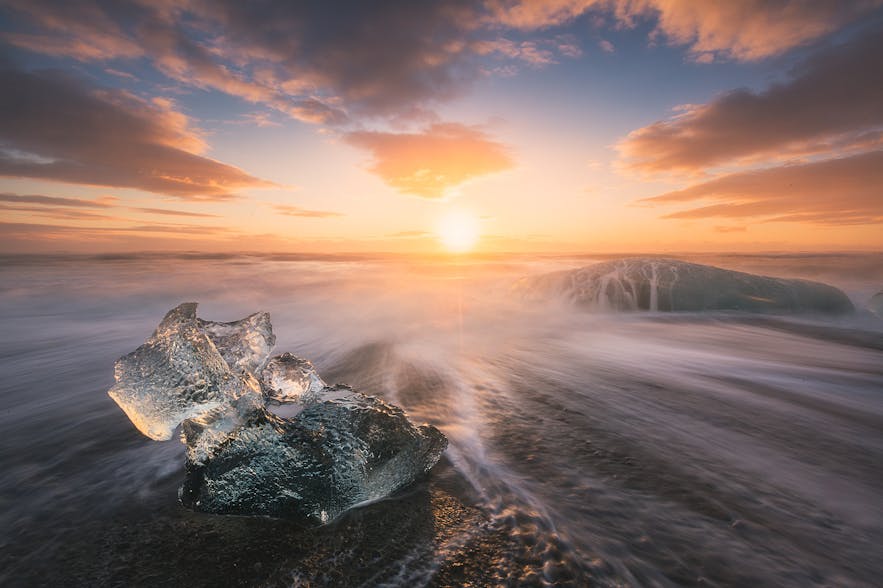 Don't stand directly in front of icebergs when a wave comes in! Photo by: 'Iurie Belegurschi'.
Don't stand directly in front of icebergs when a wave comes in! Photo by: 'Iurie Belegurschi'.
At Iceland Photo Tours, we've been photographing the Diamond Ice Beach for yonks. So believe us when we say that to stay safe while shooting at the Diamond Ice Beach in Iceland, you'll need to pay attention to the basics below:
-
Waders / Over Shoes / Rubber Boots and Waterproof Pants are a must. The waters are cold, so you'll need to stay dry and warm. Once your feet get wet and cold, it's very likely that you won't be able to continue shooting for much longer.
-
Arrive early and observe the strength of the waves. This beach is notorious for waves that claim cameras, tripods, as well as lives. As such, it is best to scout the area and find out if you are shooting approaching high tide or low tide as the icebergs interact differently with the swells of the water.
-
If the tide is coming in, then you'll need to continuously keep moving backwards as you shoot, so as not to get swept away. On the other hand, if the tide is on the way out, then there's no use waiting around for the water to come in closer to an iceberg that you've decided to concentrate your efforts on, as it probably won't get that high again for quite a few hours!
-
Do not stand directly in front of any big chunks of ice. You run the risk of being hit by the iceberg once a big wave pushes it forward. Also be mindful of any razor sharp fragments of the ice with the potential to hit your legs.
-
While shooting, you should also keep an eye on any icebergs that might be sitting on the sand behind you. When a big wave comes in, those pieces of ice can get dragged back out to sea, taking you and your camera gear with them.
What Camera Gear You'll Need to Get Ice Beach Photos
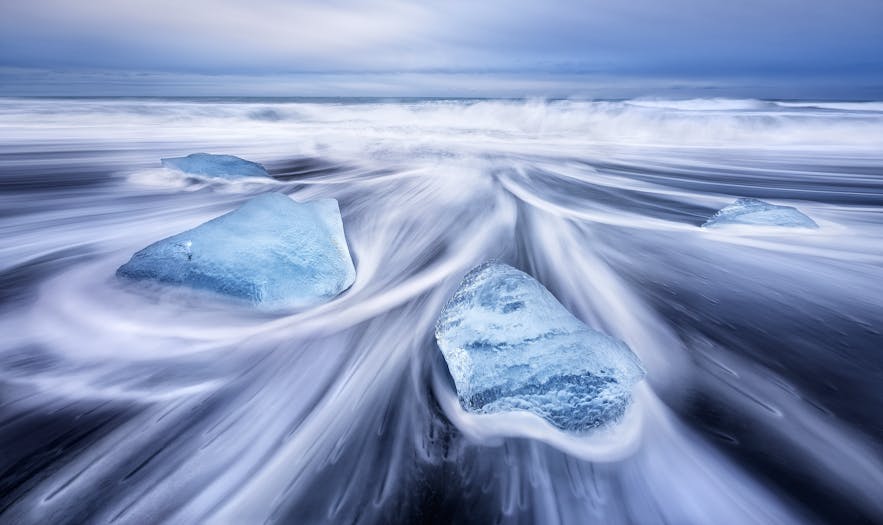 Wide angle lenses let you get up close enough to exaggerate the action. Photo by: 'Iurie Belegurschi'.
Wide angle lenses let you get up close enough to exaggerate the action. Photo by: 'Iurie Belegurschi'.
Now that we've gone over some of the safety issues, let's take a look at the best camera equipment for photographing the Diamond Beach in Iceland.
-
Camera with an Ultra Wide Angle Lens (for example 16-35mm). You'll want to get close up to the icebergs to exaggerate their size and to make them look bigger against the horizon, so a wide angle lens is a must.
-
Filters. These will help you to get the drawn-out effect in the water, but also to balance out the exposure in the foreground and the sky. A good place to start is with 3 stop and 6 stop neutral density filters, as well as 0.6 and 0.9 HE graduated filters.
-
If you do not have ND Grad Filters, you can still do bracketed shots. Just keep in mind that your shooting time will be limited only until you can control the light and staying within certain shutter speeds, which we'll discuss below.
-
Bring a sturdy Tripod. Light travel tripods are not recommended for the Diamond Ice Beach, as they can easily get swept away.
-
Release Trigger, to help reduce camera shake as you line up for your shot!
-
It's also useful to have some microfibre cloths or towels in your pockets to dry off your filters and lens from any water spray that may accumulate while you're shooting. Always check your glass to make sure that there are no drops. The last thing that you'll want is for a perfect photograph to be ruined by a big splodge of water!
-
A Sling filter pouch or a camera vest. When photographing waves, it is best to have both hands free in case of any situation, so you'll want to keep your gear safely attached to you or in your pockets. If you have a camera bag, then make sure that it is on your back at all times, as the waves can be unpredictable and rise so high that they'll wash your gear away.
Now that you've got the low-down on what equipment you'll need at the Diamond Ice Beach, let's take a look at how to actually shoot it.
Tips for Shooting at the Diamond Ice Beach
When photographing at the ice beach, try to find interesting fragments of ice, which will make for a good subject to focus on. It's best to choose icebergs that are blue, cyan or transparent in colour, as they will contrast better against the sky and the foam. Murky pieces of ice tainted in white or grey will blend in with the waves, making it very difficult to see them in your shots.
Once you've found a piece of ice to focus on, roughly compose your shot and mount your tripod firmly in the sand. It's best to have the legs dug a few inches into the sand to prevent them from moving once the waters go in and out from under your tripod.
As the waves move in and out, you may experience some vibration in your tripod. If you need some help to keep it steady, then it's best to grab the tripod around its neck and to push it down into the sand as the waves come in and retreat.
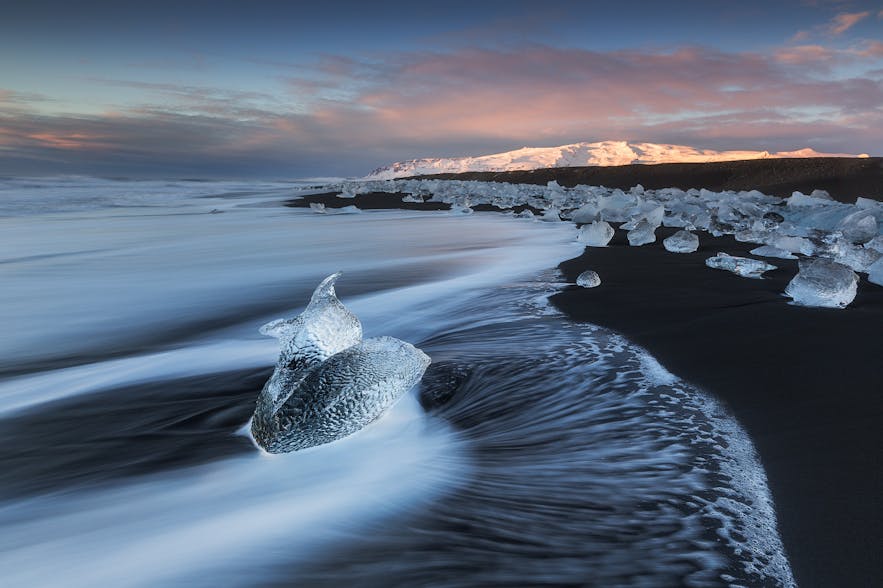 Look for interesting compositions with the ice. Photo by: 'Iurie Belegurschi'.
Look for interesting compositions with the ice. Photo by: 'Iurie Belegurschi'.
If you've settled on your composition, keep in mind that the smaller the icebergs, the lower you will have to mount your camera for them to become dominant focal points on the foreground. The trick is to find medium-sized icebergs, so that you won't have to dip so close down to the water that you'll risk your camera getting wet.
Although the larger sized icebergs can be quite impressive to look at, they'll be difficult to frame in your shots, so when possible, go for the ones that run about average.
The trick to photographing the ice beach is to adjust your camera settings before you start. That way, you won't have to fiddle too much while you're trying to shoot. Set the white balance to Auto, aperture to F11-F16 to ensure that everything is sharp and in focus, adjust your ISO to get the right amount of exposure and you're ready to go.
During twilight, you will start off with a higher ISO around 200-400, then work yourself down to ISO 50-100 once the sun rises.
Once you are done with the settings, mount your filter holder and ring and apply your ND and GND filters to your lens. You will need your 3 stop ND during sunrise, and 6 stop ND during golden hour to achieve the desired shutter speeds.
Your GND filters will help to provide a balanced exposure between the sky and foreground. Depending on the conditions, you may need to switch between a 2 and 3 stop Hard Edge to get a healthy histogram.
If using a hard edge filter, make sure that it is inserted in such a way that the graduation line sits exactly on the horizon, to prevent any unwanted darkening the ocean. Of course, if your iceberg in the foreground impinges on the horizon in any way, then you'll want to use a soft edge filter instead of a hard edge, so as not to darken the ice.
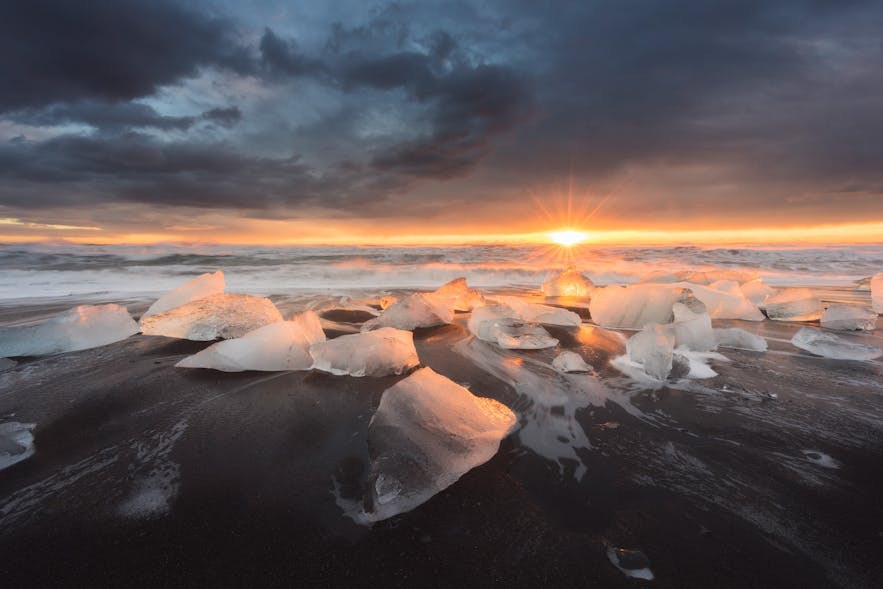 Sunstars are a good addition to photography at the ice beach. Photo by: 'Iurie Belegurschi'.
Sunstars are a good addition to photography at the ice beach. Photo by: 'Iurie Belegurschi'.
Once you have your filters in place, take a look at your histogram and make sure that it is exposed a bit to the left, or at -1 EV. Once the water foam travels on the foreground, the scene will brighten and your camera will compensate for the correct exposure.
If you do decide to not use filters, then you will need to take multiple images first for the sky (for correct exposure) then second for the foreground using the desired shutter speed.
To ensure that your images are sharp and in focus, make sure that your focus point is locked on the nearest piece of ice in the foreground, particularly if your composition consists of a few pieces scattered across different planes.
When you're ready to take the shot, use your release trigger and set your camera to burst mode. This will eliminate camera shake and allow you to capture the wave action continuously as it moves in and out from the shore, ensuring that you'll have a usable shot even while the sand is moving.
By following all of these steps above, you'll be ready for action at the Diamond Ice Beach in no time. As a guide, set your shutter speed to the values below for the following types of wave motion effects:
WAVE PAINTING – taken as the waves recede / move backward around the Ice at a shutter speed from 1 sec to 2 seconds.
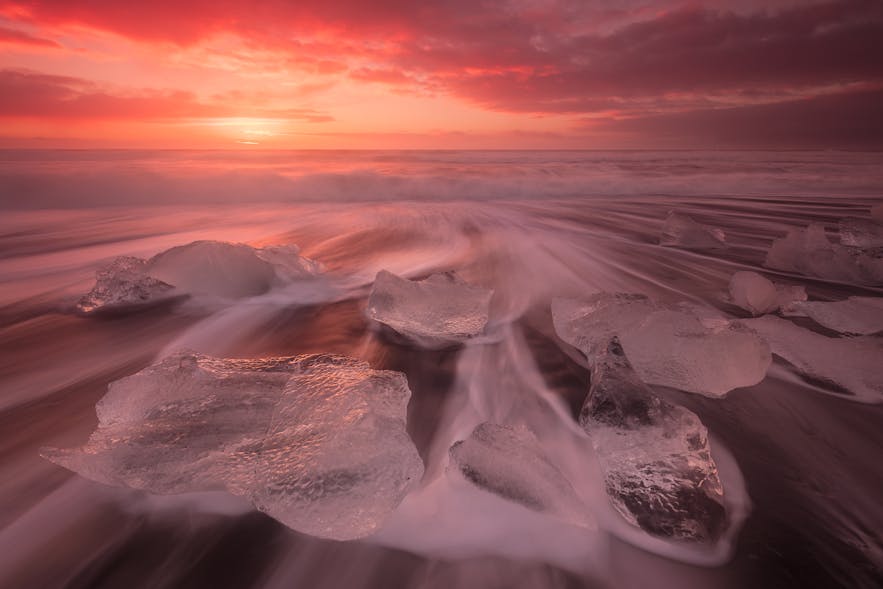 Wave painting at the Diamond Ice Beach. Photo by: 'Iurie Belegurschi'.
Wave painting at the Diamond Ice Beach. Photo by: 'Iurie Belegurschi'.
WAVE CRAWL – taken as the waves move forward at a shutter speed from 0.4, 0.6, 0.8 to 1 Second
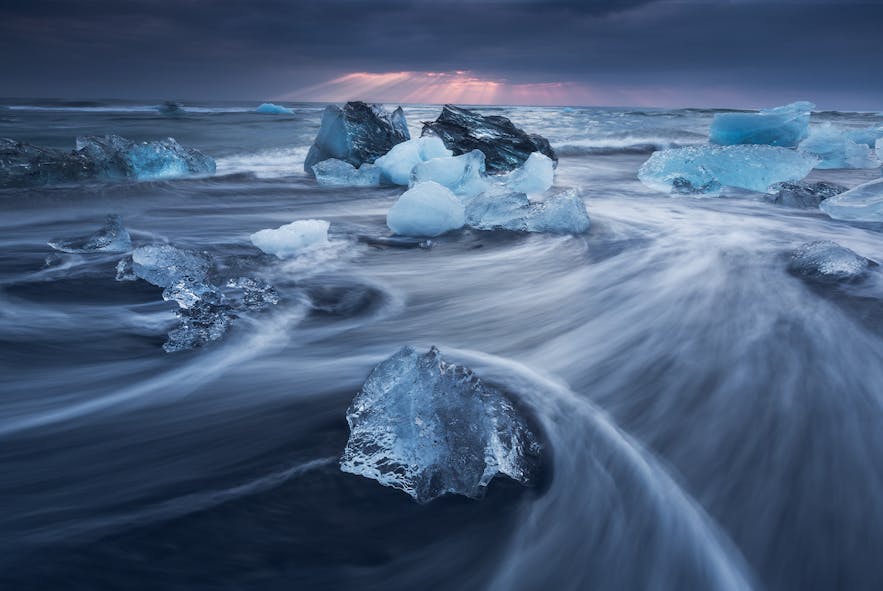 Wave Crawl. Photo by: 'Iurie Belegurschi'.
Wave Crawl. Photo by: 'Iurie Belegurschi'.
SPLASHING WAVES – taken as the waves hitting the ice at a shutter speed from 1/25 – 1/50 seconds.
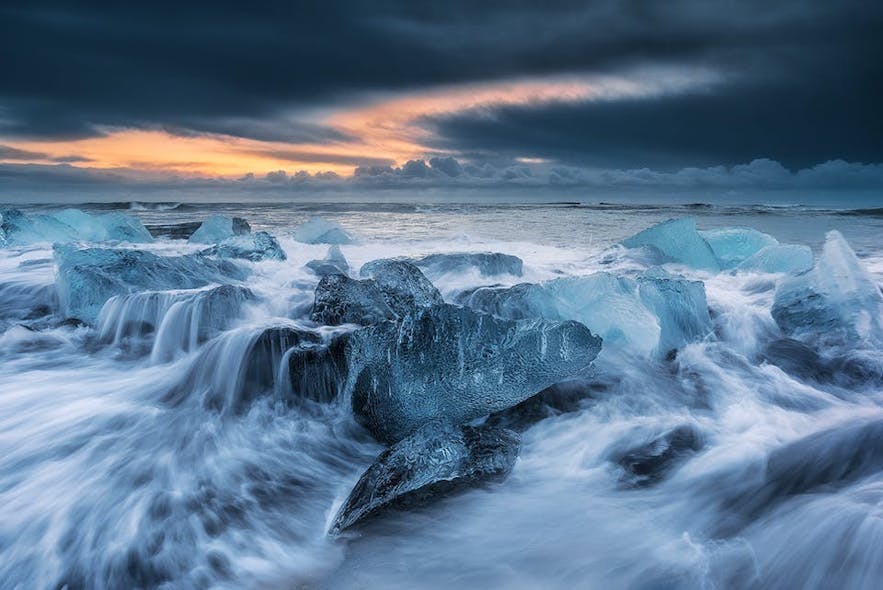
You may also include a Sun Star or a Person into your frame to give it that extra umphhh!!! Here is a sample:
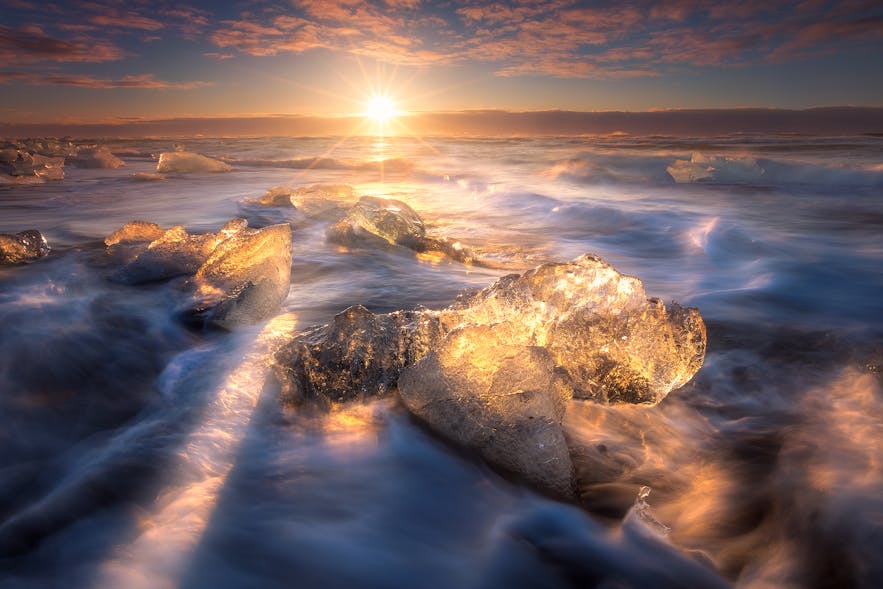 Sunburst at the Diamond Ice Beach. Photo by: 'Iurie Belegurschi'.
Sunburst at the Diamond Ice Beach. Photo by: 'Iurie Belegurschi'.
Sunbursts happen when the Sun hits the edges of the horizon or pass through clouds. To make the most of this effect, you'll need to ensure that your filters and lens are clean, as any smudges can contribute to lens flare.
Keep your aperture between F16-F22 to achieve the sunburst. Keep in mind that different lenses vary the effect and that some lenses are better at it than others. This was taken with a Canon 16-35 Mark II set at F16.
Shooting Light Through Crystal Ice
First, find a clear piece of ice with textures directly facing the sunrise or sunset. Sunrise is better, as the light is warmer and golden as it rises from the horizon. Align your tripod at the back of the ice and position it at low angle.
I recommend that you set your aperture somewhere between F8 to F11. No graduated filters are needed, just check your histogram to make sure that no highlights are clipping.
Last but not least, make sure that the ice is large enough to fill your frame but that it doesn't dominate the edges; a rounded piece of ice is also better so that the glow that shines through will be balanced.
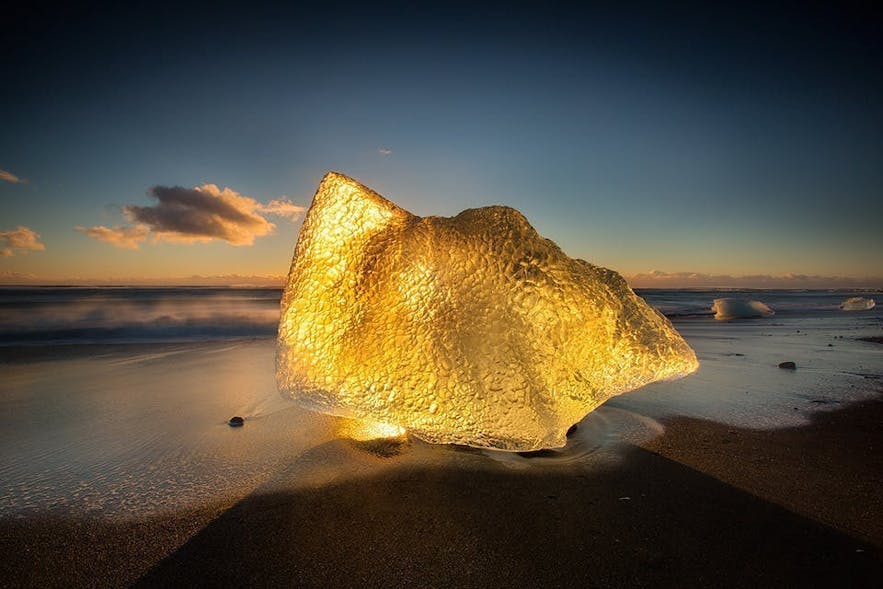
About the author: Christian Lim is a landscape photographer based in the Philippines. You can find more of his work on 500px.
Would you like to try your hand at shooting the Diamond Ice Beach in Iceland? Check out our range of photography tours and workshops that visit this incredible wonder of nature. Our experienced photo guides will teach you everything you need to know in-field so that you'll return home with stunning photos of icebergs just like the ones that you've seen here.
Other interesting articles

Beginner's Guide to Post Processing Landscape Photography
Whether you like it or not, photos need to be post-processed. I won’t even get into the fact that it’s always been like this, since analogue film cameras were in their heyday. Back then, there was j...Read more
Guide to the Aurora Forecast in Iceland
Would you like to catch a glimpse of the Northern Lights? This elusive natural phenomenon is a bucket list item for many travellers coming to Iceland. While predicting the Aurora forecast may not be...Read more
Ultimate Guide to Understanding Focus in Photography
Focus has been one of the biggest pillars of photography since the very first day someone used a camera to capture an image. We could spend days talking about composition, settings, HDR, bracketing ...Read more










